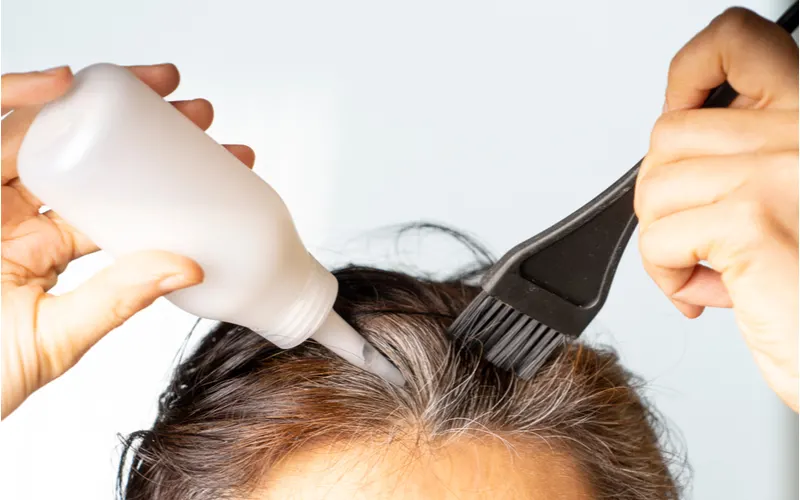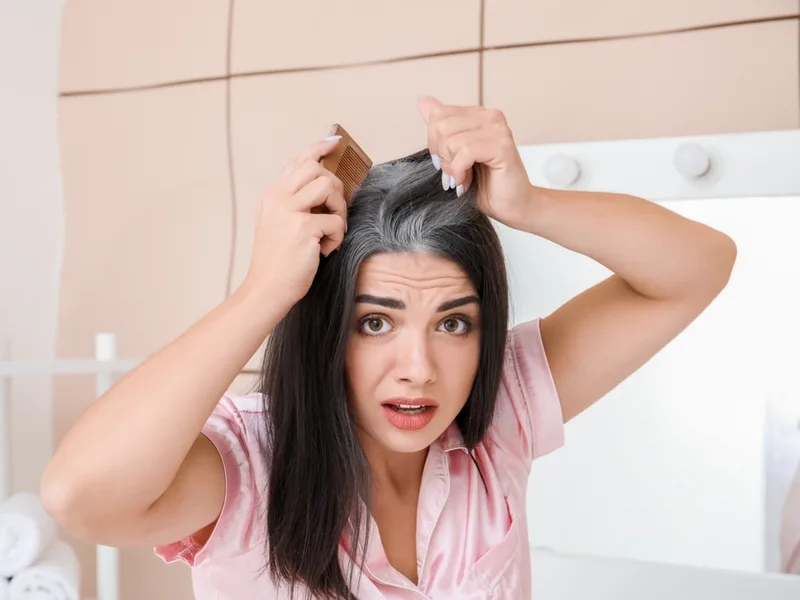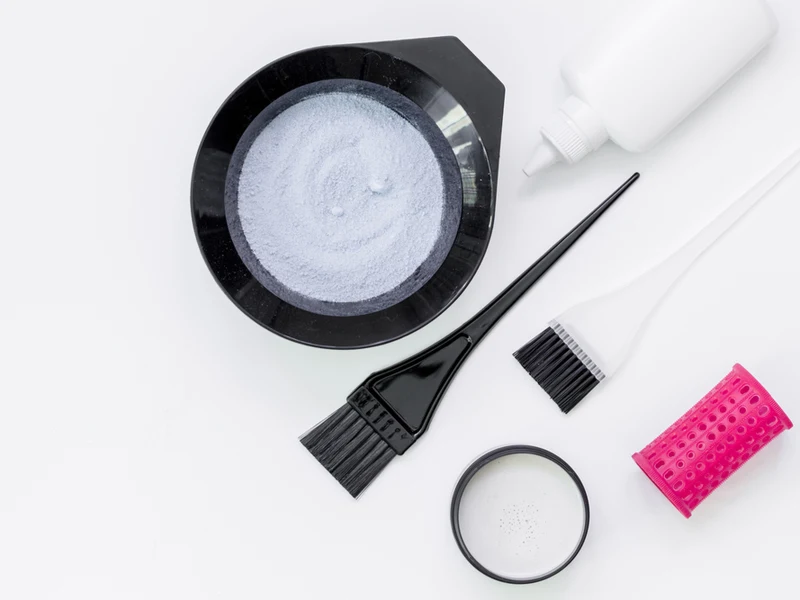Jump to:
Finding the best ammonia-free hair color to cover that pesky gray can be a small challenge if you aren’t sure where to look. Read on in this how-to guide to bring yourself up to speed about everything you need to know about the best ammonia-free hair color to cover gray hair.
Using the Best Ammonia Free Hair Color to Cover Gray

Veja/Shutterstock
This overview of the best ammonia-free hair color to cover gray hairs will take you through everything you need to know about ammonia-free hair care products, including when and how to use them.
Hair coloring products even raise questions for hair care gurus at the best of times, leaving the majority of us wondering:
- What is so special about ammonia-free hair coloring products?
- Which ammonia-free hair coloring products should I use?
- Does ammonia-free hair color look professional?
- Is all-natural hair color actually going to cover my grays?
These questions make choosing your at-home hair color seem like a final exam if you’re unfamiliar with the ins and outs of ammonia-free hair care. For example, many of us have seen ammonia-free labeling, but only a few know what ammonia-free means and why it matters.
We delve into the origins of ammonia and what makes ammonia-free hair color so different to make sure to cover you, literally and figuratively, from top to bottom.
The Importance of Ammonia-Free Hair Color

John Rehg/Shutterstock
Concern for wellness is at the tip of our tongues and the roots of our hairstyles these days. Nothing brings to mind wellness more than all-natural and ammonia-free hair care products.
While permanent hair dyes historically dominated the hair color market, now men and women worldwide are looking for softer solutions that still color their hair without all the damage. Many of us have heard that ammonia-free color isn’t that great for us.
And it certainly isn’t that great for the environment. However, few of us really know why and aren’t willing to give up on tried and true permanent dyes in favor of something gentler.
This shift to hair health-enhancing products leaves many of us asking ourselves, is ammonia-free hair color really the best choice for me, and, if so, why?
What Is Ammonia?
Ammonia is a commonly used industrial chemical naturally produced by decaying plant and animal matter, but that can also be manufactured artificially. Most of the manufactured industrial ammonia winds up in agricultural fertilizer.
However, ammonia also plays a central role in many household and industrial cleaners and equipment, including air-conditioning and wastewater treatments. In cosmetic products, ammonia stabilizes pH levels causing the hair cuticle to open.
Ammonia in Hair Color
Ammonia is used in hair color to help your hair absorb the color of the dye. After applying hair dye, ammonia in the hair color raises the pH level of the hair.
This heightened pH level causes the outer layers of the hair cuticle to swell and open in order to deposit the color deep into the hair shaft. To put it more simply, ammonia causes the outer layer of your hair to open so that the color can stick to the inner layer.
Ammonia can also lighten the pigment in your hair so you can dye it again. The reason ammonia can lighten hair is that it is a stripping agent that also removes dirt and oil from hair before color is applied.
However, the effectiveness of ammonia as a coloring additive does not come without potential risks you should bear in mind.
Risks of Using Ammonia
The largest risk of using ammonia that most people are aware of is that it can seriously damage your hair. Using ammonia-based dyes frequently can damage the cuticle of your hair strands.
Damage to the cuticle, in turn, allows moisture to escape and leaves your hair feeling brittle and dry. Over time, this also harms the foundational structure of your hair and can leave coarse hair feeling coarser, which is already a challenge for many with gray hair.
Other health risks associated with ammonia are more severe, involving the chemical making its way to other parts of the body. This risk can be very severe as chemicals used in hair color products have been tied to an increased risk of cancer.
When ammonia is in contact with the scalp, there is a chance the bloodstream can absorb it. Similarly, the fumes from ammonia in hair dyes can cause eye irritation and breathing problems, including sinus and throat infections.
Using ammonia in haircare products also carries the risk of causing skin irritation. When ammonia dissolves in water, it forms ammonium hydroxide, which causes the itchiness or irritation you sometimes feel when dying your hair.
With these potential risks from using ammonia-based hair dyes, it is hardly surprising that people are increasingly turning to ammonia-free alternatives.
When to Use Ammonia-Free Hair Color for Gray Hair
When choosing your ammonia-free hair color for the first time, there is no doubt you’re wondering if it is right for you, which ingredients to avoid, and which brand to pick.
When ammonia-free hair color is applied correctly, it offers many benefits that nourish and revitalize your hair in a way other hair dyes cannot.
Benefits of Using Ammonia-Free Hair Color
Using ammonia-free hair color to dye your hair decreases your risk of having an allergic reaction or skin irritation. Some hair dyes that include ammonia contain other ingredients that can irritate the skin or cause an allergic reaction.
It is best to avoid hair color with ammonia if you’re at high risk of having a bad skin reaction. The best ammonia-free hair products for covering gray hair offer a natural-looking finish since they don’t open up the hair cuticle. Ammonia-free products can help increase the overall shininess and luster of your hair.
These ammonia-free products work by sealing the hair strands previously opened by chemical damage. After rinsing your hair, the result is shiny and sleek hair with edges smoothed over by the ammonia-free hair color.
Covering Gray Hair

Pixel-Shot/Shutterstock
Covering gray hair can be tricky and reaching for the first product on the shelf might seem like z viable solution but there are a few things to keep in mind when choosing an ammonia-free hair color to cover gray.
Semi and demi-permanent dyes are a popular alternative to permanent dyes for coloring gray hair. Unlike permanent dyes, ammonia-free hair colors are better for masking and blending in new hairs growing in.
Drawbacks of Permanent Dyes
In contrast with permanent dyes that last longer, ammonia-free products are semi- or demi-permanent and are designed to wash out over several weeks or months.
While this may seem like a disadvantage, some of the best products for covering gray hair color are ammonia-free dyes. Darker, permanent hair colors tend to show gray roots faster and can make hair look flat and unnatural, particularly when those roots start to appear.
Blending
Adding highlights to gray hair is one way to blend your natural color with a dyed color when your hair is less than 50% gray. However, once your hair is more than 50% gray, adding highlights can create a look that is more spotty as opposed to covering the gray.
At this point, it may be better to switch to using a semi-or demi-permanent dye that you can touch up more frequently. Ammonia-free hair dyes usually wash out more quickly than permanent dyes and, consequently, are a good choice for beginners.
Ammonia-free dyes also prevent your hair from becoming too dark and flat-looking, as can happen with permanent hair colors.
To cover your gray hair with an ammonia-free dye, pick a shade that is one shade lighter than your natural color. Choosing a lighter shade will help blend your natural hair color with the ammonia-free color and eliminate the dreaded risk of your hair looking too dark.
Frequently Asked Questions

279photo Studio/Shutterstock
Knowing what ammonia-free hair color is and how to use it sometimes isn’t enough. These frequently asked questions often come up when talking about the best hair color to cover grays and tackle the tricky details that you might not know you needed to know.
What are ammonia-free hair color side effects?
Monoethanolamine, or MEA, is the chemical used to replace ammonia in ammonia-free products. However, MEA can still damage your hair, just not as severely as hair dyes that include ammonia.
You should review the ingredients carefully before purchasing any hair care products. Some studies have shown that some ammonia-free hair color that uses MEA is more damaging for your hair than color with ammonia.
What are the pros and cons of ammonia-free hair color?
Ammonia-free hair color is regularly identified as the ideal solution for dried-out hair that has been fried from too much overcoloring. However, ammonia-free hair care products come with a list of pros and cons of their own.
Pros
- Less damaging to the hair strand and cuticle
- Ammonia-free dyes don’t cause skin irritation or damage
- Help preserve hair’s strength
Cons
- Products may include other substitutes for ammonia with negative effects
- Ammonia-free hair color still may not be all-natural or organic
What are professional ammonia-free hair color brands?
With modern advances in cosmetology, there is a large number of professional-grade, ammonia-free hair coloring products that are available to the average shopper from the comfort of their own home. Brands offering professional quality products include Garnier, Clairol, Revlon, Matrix, Good Dye Young, Wella, Madison Reed, and Manic Panic.
Does ammonia-free hair dye cover gray?
Ammonia-free and demi-permanent hair dyes may be less effective in covering gray hairs, depending on the texture of the hair. Ammonia-free products can be effective if you’re just beginning to see gray hairs appear, but some hairstylists don’t like ammonia-free colors since they won’t completely cover gray hair that is coarse in texture.
How often can you use ammonia-free hair dye?
Ammonia-free hair color still requires a small amount of peroxide to dye your hair. Peroxide lifts the outer cuticle of your hair so that pigment can take hold. You can use ammonia-free hair dye 3-4 weeks after your initial dye to allow your hair cuticle enough time to recover and return to its usual closed position.
So, What’s the Best Ammonia-Free Hair Color to Cover Gray?
Choosing the best ammonia-free hair color to cover gray hair can seem daunting, especially since it’s a decision that you wear every day. In this overview, we took you through everything you could need to know about ammonia-free hair color, how to choose it, and how to apply it.
Hopefully, you now have the skillset you need to choose the best ammonia-free hair color to cover grays with confidence and to keep you looking your best year-round.
